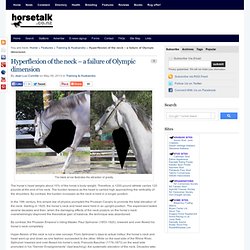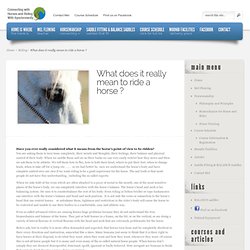

Veterinary Integrative Performance Services, Inc. - Dr. Christine Woodford. Return to Publications and Articles ....

Dr. Christine Woodford We must take careful measures to prevent strain on ligaments, tendons, and joints to keep our equine athletes performing at their peak level. There are many products on the market that claim to aid in the protection of these structures. The most common joint supplements are chondroitin sulfate, methylsulfonylmethane (MSM), glucosamine, polysulfated glycosominoglycan (Adequan) and hyaluronic acid (HA). These supplements support joint health by slowing the cartilage degeneration process. Condroitin sulfate is one of the primary glycosaminoglycans in joint cartilage. Methylsulfonylmethane (MSM) is a white, tasteless, odorless, crystalline powder, which has probably been the nutraceutical used for the longest period of time. Glucosamine is an amino acid that is present naturally in the body. Hyaluronic acid is an important component of articular cartilage and synovial joint fluid.
Pregnancy and foaling. How To Engage Your Horse's Back - corrected version. Caution urged over use of negative reinforcement - Focus, Training & Husbandry. A Danish researcher is urging horse owners to use caution when using negative reinforcement to get horses used to unfamiliar objects.

Janne Winther Christensen, from the Department of Animal Science at Aarhus University in Tjele, carried out her research on habituation using 22 two- to three-year-old Danish warmblood geldings. Christensen said that the ability of horses to get used to novel objects influenced safety in the horse–human relationship. However, the effectiveness of different techniques to achieve this aim had not been investigated in detail, she noted. Christensen set about investigating whether horses showed increased stress responses when negatively reinforced to approach novel objects, compared with horses allowed to voluntarily explore the objects, and whether a negatively reinforced approach aided object habituation. Half of the horses were negatively reinforced by a familiar human handler to approach a collection of novel objects in a test arena. Christensen, J. FS525. The Basics of Equine Behavior Carey A.

Williams, Ph.D., Extension Specialist in Equine Management Published 7/22/2004 Fact Sheet #525 Ten Natural Survival Traits The horse, a prey animal, depends on flight as its primary means of survival. Senses A horse’s vision is its primary detector of danger. Research Shows Responses to Flexion Tests can be Measured. Hyperflexion of the neck - a failure of Olympic dimension - Featured, Training & Husbandry. The black arrow illustrates the attraction of gravity.

The horse’s head weighs about 10% of the horse’s body weight. Therefore, a 1200-pound athlete carries 120 pounds at the end of his neck. The burden lessens as the head is carried high approaching the verticality of the shoulders. By contrast, the burden increases as the neck is held in a longer position. Anatomical Atlas of the Equine Neck. Anatomical Atlas of the Equine Neck Occipital Bone Cranial C1 Middle C1 Caudal C1 Cranial C1-C2.

What does it really mean to ride a horse ? Have you ever really considered what it means from the horse’s point of view to be ridden?

You are asking them to turn loose completely, their minds and thoughts, their feelings, their balance and physical control of their body. When we saddle them and sit on their backs we can very easily restrict how they move and then we ask them to be athletic. We tell them how to flex, how to hold their head, where to put their feet, when to change leads, when to take off for a jump etc. …… so we had better be sure we understand the horse’s body and have complete control over our own if we want riding to be a good experience for the horse. The sad truth is that most people do not have this understanding , including the so called experts. Caution urged over use of negative reinforcement - Focus, Training & Husbandry. The Horse's Skeleton: Overview. The Umbrella Study: How your horse reacts to the beat of your heart. A Forage-Only Diet for Young Horses in Training Evaluated (print) KB Equine Therapy: Happy New Year... Well it has been quite a year, The update on Holly is that she is doing well.

We are now giving regular MFR treatments to help supple the scar tissue we are also using passive stretching and sports massage to release any tension in the lumbar area resulting from the surgery in her lower leg. Holly however is leading her owner Claire a merry dance.. Claire went to bring her in from her small recovery paddock only to find she had escaped! It was really foggy and all claire could see was a horse shape lying in the field... Update from the Haighs Yard; Zoe has a new dressage horse CeeJay, sh is doing really well with him. Quote from Zoe: "Your magic hands worked.... 68% and we qualified for the nationals.
Although I am based at Bogs Hall Stables I have been asked to work at a fab yard at Warsill near Brimham Rocks- Farm View Livery , They have really good facilities run by Gemma Newcombe and are starting a series of clinics, watch out for some exiting things happening here. Home - SYKEHOUSE ARENA.
Equine back problems. Equine lameness. Equine Anatomy.